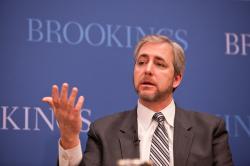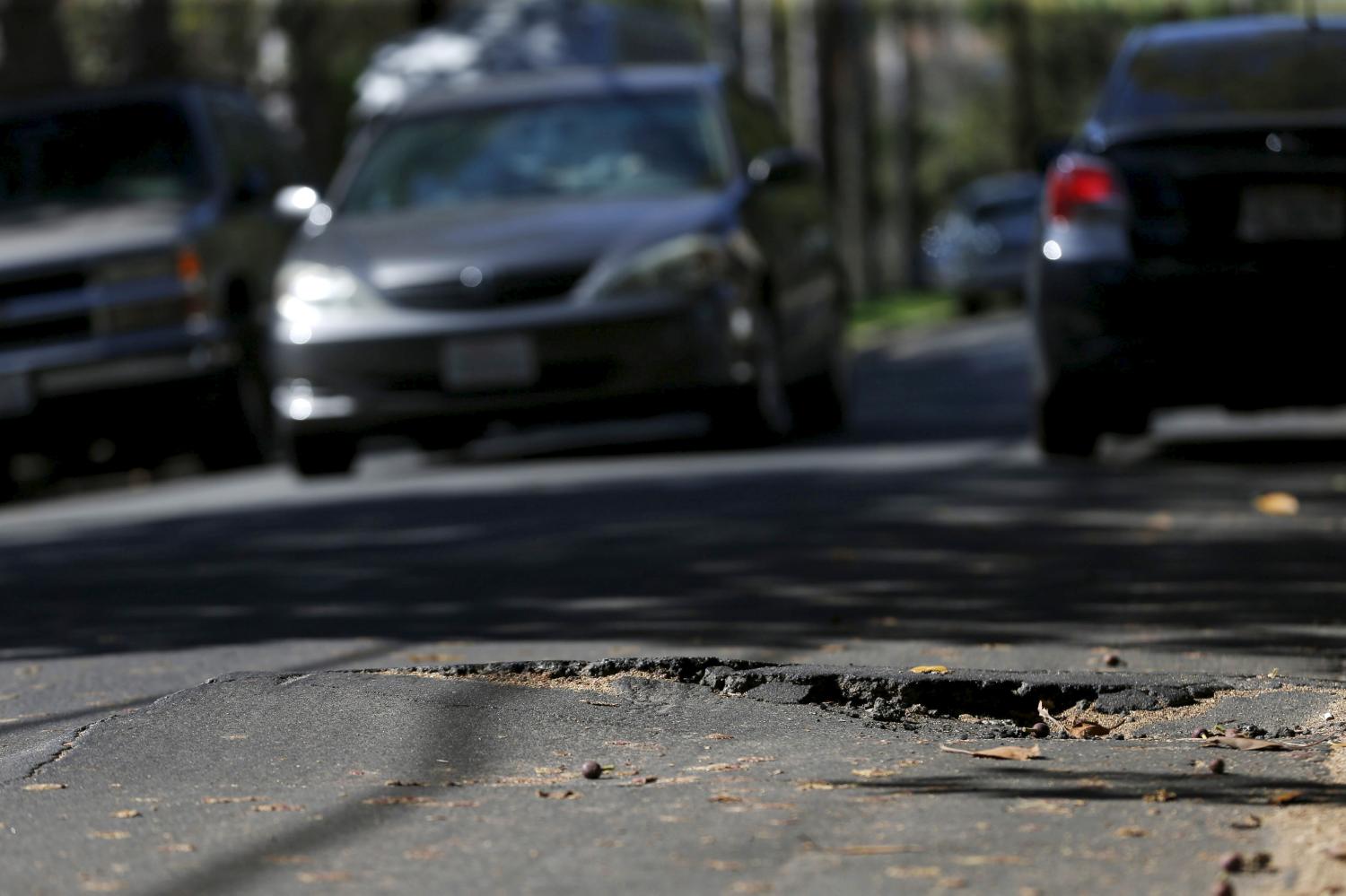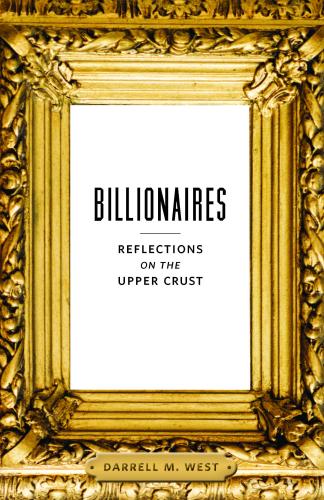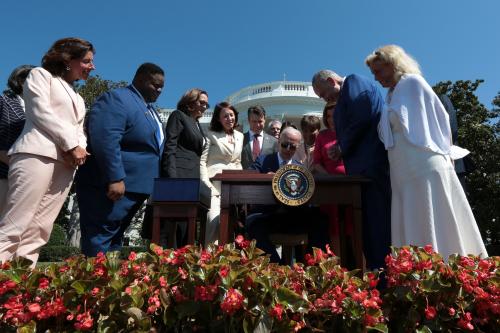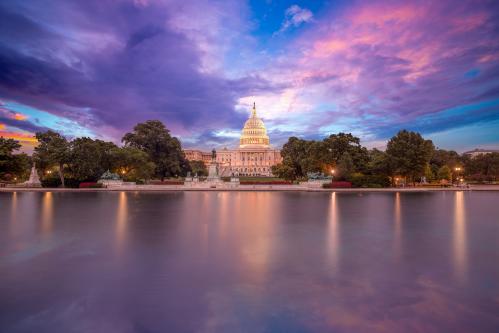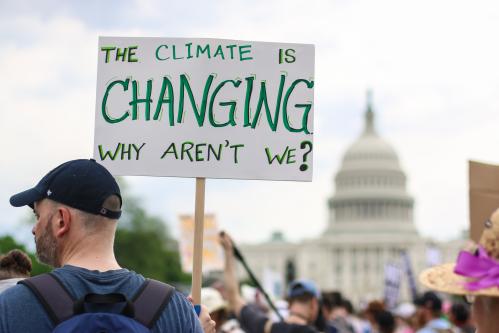The following brief is part of Brookings Big Ideas for America—an institution-wide initiative in which Brookings scholars have identified the biggest issues facing the country and provide ideas for how to address them. (Updated January 24, 2017)
Complacency is not an option for the next president, should he or she hope to avoid a presidency marred by collapsed bridges, increasing traffic congestion, and overworked power grids. Rather, it is essential that the presidential candidates develop strategies for utilizing the federal government to: address our basic infrastructure needs and shore up existing programs, especially in support of surface transportation; enhance existing public financing mechanisms; and leverage private capital to fund lucrative infrastructure projects.
By closing the infrastructure investment gap, the future president will not only improve our nation’s most critical assets. He or she will also be responsible for boosting job creation, enhancing economic growth, connecting households across metropolitan areas to higher quality opportunities for employment, health care, and education, and finally, reducing greenhouse gas emissions and helping to protect the nation from an increasingly unpredictable natural environment.
Introduction: Why infrastructure matters
Since the beginning of our Republic, infrastructure—starting with transportation and water management—has played a central role in advancing the American economy. From the railroads that linked the heartland to industrial centers to the interstate highway system that forged regional connections, a sharp focus on prioritized, strategic, and rational infrastructure investments underscored periods of regional growth and national prosperity. But what the our country once understood, we seem to have forgotten. During the past three decades the United States has significantly underinvested in infrastructure. This shortfall has made it difficult to maintain existing infrastructure assets and impossible to create a globally competitive system. Our failure to meet long-term infrastructure requirements has impaired economic efficiency, impeded the creation of stable middle-class jobs, and slowed our response to the threat of climate change. It also is imposing direct costs on individuals and businesses. Several studies have documented sharply higher costs for vehicle maintenance and have attributed much of that increase to poor road conditions.
Our nation’s infrastructure is in desperate need of upgrading and modernization.
From highly publicized bridge collapses and levee breaches to airport delays and traffic congestion, every American has experienced the frustration—and in some cases the dangers—of aging, overcrowded, under-maintained facilities.
Closing the infrastructure investment gap would have at least four beneficial consequences. First, it would boost the creation of jobs that often provide middle-class wages and opportunities to workers with modest levels of formal education. Second, it would enhance economic growth by decreasing overhead cost to business while efficiently moving people, goods, and ideas. Third, it would better connect households across metropolitan areas to higher quality opportunities for employment, health care, and education. Fourth, it could reduce greenhouse gas emissions while helping to protect the nation from an increasingly unpredictable natural environment. For these reasons, among others, presidential candidates would be well advised to address infrastructure issues.
The problem
“In a growing economy,” a Congressional Research Service paper notes, “infrastructure should hold its own, but other data show that that has not been the case. While total government spending on infrastructure adjusted for inflation increased from $92 billion in 1960 to $161 billion in 2007, it actually declined from $1.17 per capita in 1960 to $0.85 per capita in 2007.”1 According to one expert, “from 1950 to 1970 we devoted three percent of GDP to spending on infrastructure….[s]ince 1980 we have been spending well less than two percent, resulting in a huge accumulated shortfall of needed investment.”2 Just since 2002, CBO estimates, inflation-adjusted spending for highways at all levels of the federal system has fallen by 19 percent.3
Political wrangling and dysfunction mean that the federal government has ceased to be a reliable partner and effective leader.
The problem runs from top to bottom. Political wrangling and dysfunction mean that the federal government has ceased to be a reliable partner and effective leader. Furthermore, the rise in federal interest payments, the increase in entitlement spending, and the decline in traditional sources of government revenue, such as the gasoline tax, mean that competition for limited resources is fierce.
By contrast, some cities and states now see budget surpluses due in part to increases in property tax revenues and state level sales tax collections. However, it will take years for most localities to build back their reserves, repay debt incurred during the Great Recession of 2007-2009, and pay for deferred maintenance on a range of infrastructure assets. Cities and states typically rely on the bond market to finance long-term projects. But even though interest rates remain at historically low levels, the ability of many governments to borrow from the capital markets is hindered by debt caps and weak credit ratings. And because virtually all state and local governments have balanced budget requirements, they must establish their ability to repay before borrowing. In addition to managing the lingering effects of the Great Recession, many states and localities must confront a limited fiscal capacity as they are squeezed between soaring costs for health care and for criminal justice but slowly growing revenue sources.4 Combined, these circumstances constrain their ability to self-finance projects, leading officials to scale back, delay, or cancel projects altogether.
This shortfall renders the United States less competitive in the global market. The World Economic Forum’s 2014-2015 Global Competitiveness Report ranks the overall quality of U.S. infrastructure twelfth in the world, down from seventh place just eight years ago. We rank poorly in every category, with especially low marks for the quality of our roads, ports, railroads, and—the most precipitate decline—air transport infrastructure and electricity supply.5 As the Urban Land Institute succinctly put it: “to be competitive in today’s world, it is imperative to invest in infrastructure.”6
Possible responses
-
Fix the basics
First, the next president must determine how best to use the federal government to fix the basics and shore up existing programs, especially for surface transportation (roads, bridges, and transit).
The Highway Trust Fund. Funded primarily through the federal gas tax, the Highway Trust Fund distributes grants to the states to support the interstate system and other highway projects.7 These grants, however, are not subject to scrutiny, competition, or even basic calculations to assess need. Instead, they are allocated based on formulas, yielding not only inefficiencies, but also perverse incentives. The U.S. Government Accountability Office found that the federal transportation program is functioning to some extent as a “cash transfer, general purpose grant program.”8 The federal government must lead in those areas where there are clear demands for national uniformity to match the scale or geographic reach of certain problems, such as global logistics and freight movement.
The gas tax, which currently stands at 18.4 cents per gallon, has not been increased since 1993—despite the fact that project costs have gone up significantly. As cars and trucks become more efficient and infrastructure ages, revenues cannot keep up with demand. But public resistance to a federal gas tax increase to support the current program is intense.9 The result: an endless series of short-term funding patches that make planning and completing long-term projects much harder than it should be. If raising federal gas taxes is politically infeasible, the next president and Congress should propose viable alternatives.
Passenger facility charges. The federal government should allow greater flexibility for states and cities to innovate on projects that connect metropolitan areas. For example, passenger facility charges, which are used to fund airport modernization, are artificially capped at $4.50 and do not come close to covering many airports’ operating and long-term investment costs. The busiest passenger airports need to be empowered to meet their larger-than-average congestion and investment costs without federal impositions or caps.
Tolling and pricing mechanisms. The archaic restrictions on interstate tolls should also be lifted. Acting in conjunction with the states, metropolitan and local leaders are in the best position to determine which interstate roadway segments are the strongest candidates for tolling strategies.
-
Innovation and financing
Second, the next president should determine how to use the federal government to enhance existing innovative financing mechanisms.
Tax-credit bonds. Tax credits bonds such as Build America Bonds (BABs) are a cost-effective means of subsidizing borrowing because every dollar of federal revenue forgone by the tax credit is transferred directly to the borrower (states or localities) rather than the investors (purchasers of the bonds). They also offer a more generous subsidy of interest costs and have the added benefit of broadening the pool of investors to include those that do not normally hold tax-exempt debt, such as pension funds (which are already exempt from taxes) and sovereign wealth funds (which also have no U.S. tax liability). By attracting new investors, BABs have eased the supply pressure in the municipal bond market and brought down borrowing costs. Tax-credit bonds could also be used to support a wide array of infrastructure investments, among them transportation, water and sewer projects, environmental and energy projects, public utilities, and the renovation of schools and hospitals.
Transportation Infrastructure Finance and Innovation Act (TIFIA). TIFIA bonds leverage federal funds with local and private investment by providing credit assistance through direct loans, loan guarantees, or lines of credit. While TIFIA assistance must be repaid through a dedicated revenue source (such as tolls, user fees, and other special assessments such as sales taxes), the terms are very favorable. Unfortunately, arguably the greatest strength of TIFIA—the competitive nature of the process and strong selection criteria—was eliminated in the 2012 transportation bill—a retrograde action that should be reversed.10Other financing mechanisms. There are a handful of other federal programs that have expanded funding for transportation infrastructure and encouraged private sector participation in major projects. These programs include the Transportation Investment Generating Economic Recovery grants, Railroad Rehabilitation and Improvement Financing loans, and Private Activity Bonds. One benefit of these programs is that they can be combined with TIFIA loans as well as local and private investments to further leverage federal dollars. Additionally, each program takes an innovative approach to funding and does not rely on the classic formula-based grant distribution that defines the majority of federal investments in this area.11
Although these programs are helpful, they are not sufficient to meet the United States’ 21st century infrastructure demands. The public funds available for appropriation fall far short of the needs, and as long as the ongoing squeeze in federal discretionary programs continues, significant increases will remain unlikely at best. In addition, all of the innovative funding strategies reviewed in this section (save for BABs, which have expired) deal primarily with surface transportation and are unable to address other areas that require investment—to our aviation system, electric grid, and so forth.
Technical assistance for states and localities. State and local governments often lack the technical capacity to ensure project quality and to protect the public interest. For that reason, the next president should consider creating a national-level Public/Private Partnership Unit. Housed within the Office of Management and Budget, the largest component of the Executive Office of the President, the Unit would provide states, cities, and metropolitan entities with support and technical assistance, create an environment that encourages private infrastructure investment, and begin the process of forging an integrated national infrastructure agenda.
-
Selecting Projects
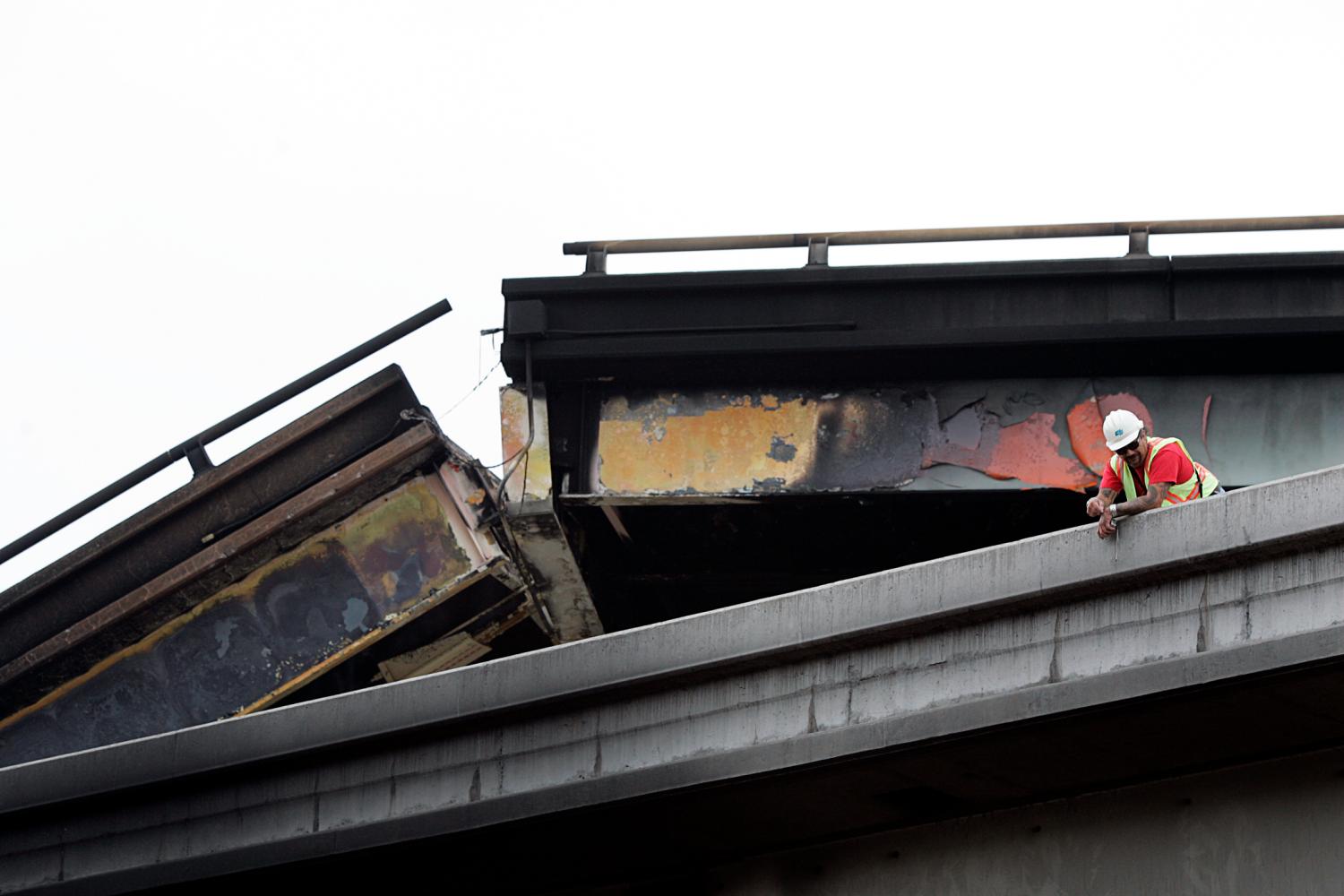
Third, the next president could push for a new mechanism to select projects that make economic sense and finance them with mostly private capital.
Numerous legislators and policy experts have suggested that the creation of a National Infrastructure Bank (NIB) would attract private investment for public purposes while ensuring that projects are funded on the basis of economic and social benefit, not political gain. Despite differences of detail, many proposals employ the same basic elements. The NIB would be a financially self-sustaining government-owned corporation established to provide a market-oriented service. A modest amount of public seed capital would secure substantial private capital. An analytical staff would provide policy entrepreneurship identifying unique opportunities to leverage private capital for public needs. Once such possibilities are identified, bank executives could convene the necessary parties and work to broker agreements among them. This approach would encourage creativity in solving infrastructure needs. And by insulating the selection of projects from the political process, it would better align infrastructure investments with real social and economic needs.12
Conclusion: Structural difficulties and strategic directions
If the expert estimates are correct, between now and 2020, we should be investing an additional $150 billion annually
Infrastructure does not typically garner headlines—until a bridge collapses or a dam bursts. It is, however, the foundation of a healthy economy and society. And it is an issue that leaders at every level of our federal system, including the president, will have no choice but to address, hopefully sooner rather than later. The need is great and growing. If the expert estimates are correct, between now and 2020, we should be investing an additional $150 billion annually in transportation and port projects, water and sewage systems, the energy grid, and much else besides.
In the current political and fiscal environment, this will not be easy. Raising general revenues by $150 billion each year for infrastructure is politically out of the question. There are four structural obstacles. First, citizens are being asked to pay now for investments that will yield a return over a lengthy period. But when household budgets are squeezed, patience to wait for future returns on spending is limited. Second, different regions have different needs: some rural and small-town voters often must drive long distances to work and shop and are highly resistant to gas tax increases. Third, it is hard to explain why tax dollars should travel to Washington, only to be returned to the states and localities. Why not just cut out the middleman? And finally, a basic difference between the federal government and other jurisdictions—Washington’s ability to borrow readily for public purposes—is diluted in times when the people disapprove of budget deficits, whatever the purpose.
These difficulties suggest that the next president should consider two very different responses. First, public pressure may support a presidential proposal to reallocate responsibilities within our system of federalism. States and localities may be more willing to tax themselves for projects if they can expect to reap the benefits directly, rather than shoring up broad national objectives. This is especially relevant today, as governments closer to the people enjoy higher levels of trust than the federal government.
Second, it may be time for a new partnership between the public and private sectors. Individual investors and large investment pools are flush with cash seeking a reasonable return at a bearable level of risk. Mobilizing private dollars for public purposes should be an easier sell than is commandeering those dollars through our system of taxation.
The devil, as always, is in the details. But the bottom line is this: an efficient modern economy cannot be sustained without public goods that the market, left to its own devices, will under-supply. As always, governments face the challenge of mobilizing public support for these goods. The art of legislation is finding the path of least resistance to reach these essential public goals. And legislators will be more motivated to seek that path when they enjoy sustained leadership and support from the executive branch. Working with governors, mayors, and the private sector, the next president must break the logjam and create a new model of infrastructure finance for the 21st century.
-
Footnotes
- Claudia Copeland, Linda Levine, and William J. Mallett, “The Role of Public Works Infrastructure in Economic Recovery” (Washington: Congressional Research Service: 2011), 3.
- Sherle R. Schwenninger, “A Capital Budget for Public Investment” (Washington: New America Foundation, 2007), 61.
- Congressional Budget Office, “Public Spending on Transportation and Water Infrastructure, 1956 to 2014” (Washington: Congressional Budget Office: 2015), 2.
- Copeland, Levine, Mallett, 1-2.
- Klaus Schwab and Xavier Sala-i-Martín, “The Global Competitiveness Report 2014-2015” (New York: World Economic Forum, 2014), 378-379.
- Jonathan D. Miller, “Infrastructure 2009: Pivot Point” (Washington and London: The Urban Land Institute and Ernst & Young, 2009), iv.
- While most of the federal gas tax accumulates in the Highway Account of the trust fund, the remainder is distributed to the Mass Transit Account and supports public transit systems.
- U.S. Government and Accounting Office, “Federal-Aid Highways,” GAO-04-802, 2004, 5.
- A recent poll found that a majority of voters would support a gasoline tax increase if it were targeted to roadway maintenance. See: Keith Laing, “Poll: Voters Would Support 10-cent Gas Tax Hike,” The Hill, April 29, 2015, http://thehill.com/policy/transportation/240527-poll-voters-would-support-10-cent-gas-tax-hike.
- William A. Galston and Korin Davis, “Setting Priorities, Meeting Needs: The Case for a national Infrastructure Bank” (Washington: The Brookings Institution, December 2013), 7-8.
- Ibid., 8-10.
- Ibid., 18-19.
